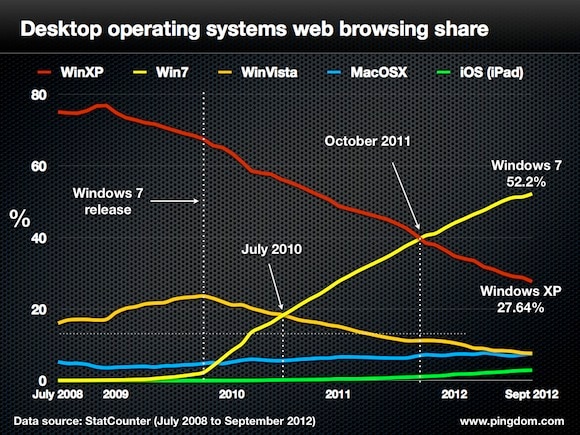
Today, millions of users around the world are installing Windows 8, the latest version of the Microsoft operating system. We will install one or more copies of Windows 8 in the Pingdom office over the course of the day.
But as exciting as some of what’s new in Windows 8 might be, it does have rather big shoes to fill. Its predecessor, Windows 7, is the fastest selling OS ever, and all Windows versions combined account for almost 90% of all desktop web browsing.
Windows’ total domination
Steve Ballmer called Windows 8 “an epic thing for Microsoft” and the start of a “new era of computing”, and there’s no doubt the new OS is a big deal for Microsoft. We will see Windows 8 grow in usage, but even now (September 2012), Windows 8 has a 0.28% share of desktop web browsing. In comparison, Linux has a 0.86% share.
Currently, eleven-year-old Windows XP still commands a 27.64% share of web browsing around the world. Its successor Windows Vista accounts for 7.58% and Windows 7 dominates with 52.2%.
If you put the versions of Windows together, you will find, perhaps not too surprisingly, that Windows accounts for close to 90% of desktop web browsing today.
This is what the usage share of various operating systems has developed from 2008 until now:

As you can see, when Windows 7 launched in October 2009, it was quickly adopted by millions of users around the world and had overtaken Windows Vista by July 2010. It took Windows 7 until October 2011, however, to kick Windows XP off the throne. Now, Windows 7 is just about twice as common compared to Windows XP. Mac OS X currently commands 7.62% of web browsing traffic.
The future is mobile
Clearly, one of the aspects of Windows 8 that Microsoft is pushing the hardest is that it’s a unified experience across platforms, i.e. computers, tablets, and smartphones. As sales of PCs is going down, it’s the tablets, smartphones, and other similar mobile devices that will see the bulk of the growth in terms of usage.
We can see this already in the web usage data, where iOS, which in this case means iPad, already accounts for 2.89% of the desktop web browsing traffic.
With Windows 8’s multi-platform approach, it will be interesting to see how things develop for the new OS. What do you think? Are you excited about the launch of Windows 8?
Image (top) from Microsoft.
























